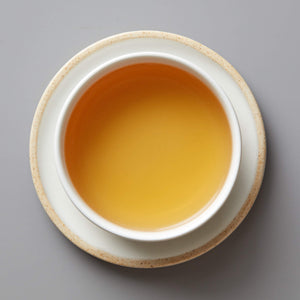Your Cart is Empty



KABUSE HOUJICHA | green
$5.00 - $64.00
KABUSE HOUJICHA is a kabuse karigane houjicha from Wazuka, Kyoto prefecture, Japan. "Kabuse" denotes a tea shaded for up to 20 days, a growing technique in which tea trees are artificially blocked from sunlight with nylon or hand-woven reed tarps to stress the plants and increase production of compounds that contribute to flavor and aroma. "Karigane" is a type of stem tea, made from the twigs sorted out during gyokuro or high-grade sencha production (this is distinct from "kukicha", stem tea made from bancha or lower-grade sencha). Houjicha ("roasted tea") is any Japanese tea that undergoes a roasting process—typically bancha or kukicha, though teas not usually roasted can also be made into houjicha. All three classifications belong to this lot from Nakai Seichajo, one of our producing partners in Uji specializing in intensively processed Japanese standards. KABUSE HOUJICHA is born of material harvested in May-June (after shading) under direction of T. Suzuki-san, processed to its mother tea (kabuse sencha) by H. Suzuki-san, refined and sorted by Matsumura-san, and slowly roasted by Kawaguchi-san. Most Japanese tea is a team effort, and Nakai's team is among Uji's finest.
For the uninitiated, "processed" is a given in Japanese teas and has no negative connotations; most teas from the archipelago are heavily processed using advanced machinery. The quality differential between them is the mastery of the operating hands at each stage, and an eye for quality producers spend decades developing. In Nakai's case, producing houjicha from kabuse/karigane material is laborious, low-yield work, painstakingly managed from field to factory for discerning domestic buyers—and us. Unlike most sorted-out material and roasted tea productions, KABUSE HOUJICHA is not a recycling effort; it's an expression of singular mastery in cultivation, processing, and roasting. It's as good as houjicha gets.
If you know us, you know we don't use claims of health effects to sell tea. That said, Japanese tea is heavily studied, and it's well-established that houjicha (of all ilk) are much lower in caffeine than unroasted teas, as the cooking process (at over 200ºC) sublimates caffeine. In Wazuka, children and the elderly regularly drink houjicha (and kyobancha for the same reason). Additionally true is that theanine—an amino acid attributed to feelings of calm—is carried from the roots of the tea tree to the leaves, passing through the stems. During photosynthesis, theanine is converted to catechins (compounds that taste bitter) in the leaf. As KABUSE HOUJICHA contains no leaves, and because it's from shaded material with more concentrated amino acids than unshaded tea, this production is very rich in theanine. For us, the relevance in that is its effect on flavor: this houjicha is hugely sweet, easy-drinking with soft body, and even vaguely fruity like cooked red apples. Steep in hot water for a solid 1-2 minutes for comforting toastiness, or cold brew overnight for a hot weather refresher.
vintage — summer '24
style — kabuse (shaded) karigane (first-flush stems) houjicha (roasted tea)
cultivar(s) —okumidori / yabukita / sayamakaori
region — Wazuka (Uji), Kyoto, Japan
locale — Nakai Seichajo
elevation — 350 meters
producer(s) — T. Suzuki / H. Suzuki / Matsumura / Kawaguchi
nomenclature — kabuse (かぶせ茶)—"covered" | karigane (雁が音茶)—"wild goose" | houjicha (焙じ茶)—"roasted tea"
STEEPING PARAMETERS
(use freshly boiled spring water)



